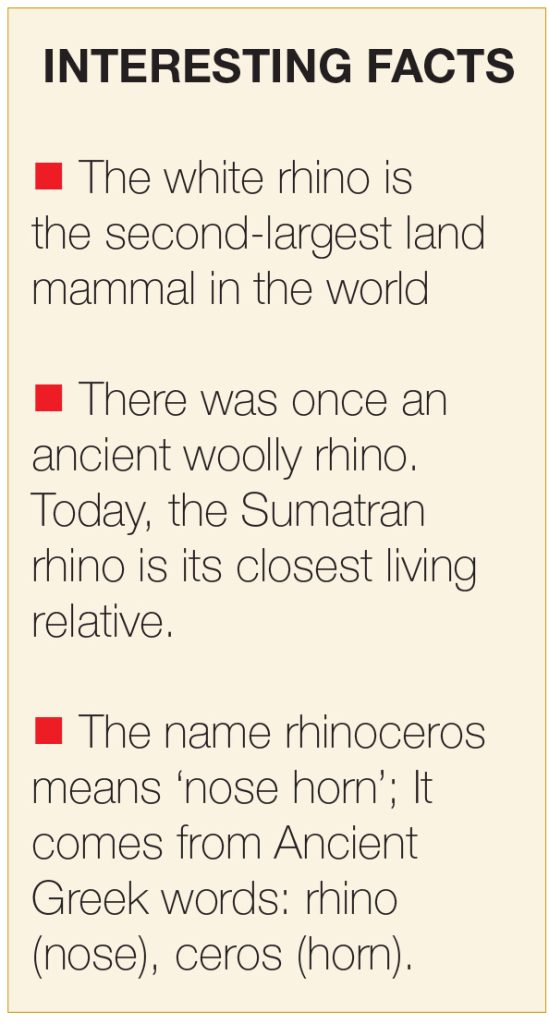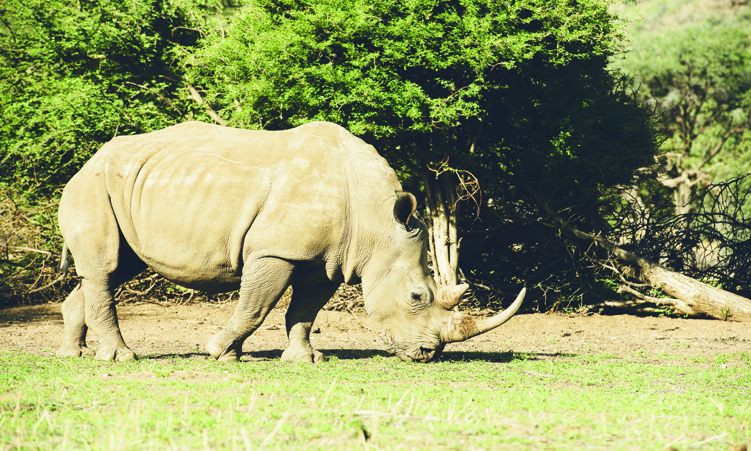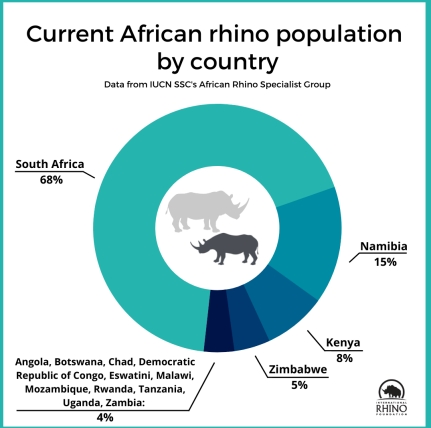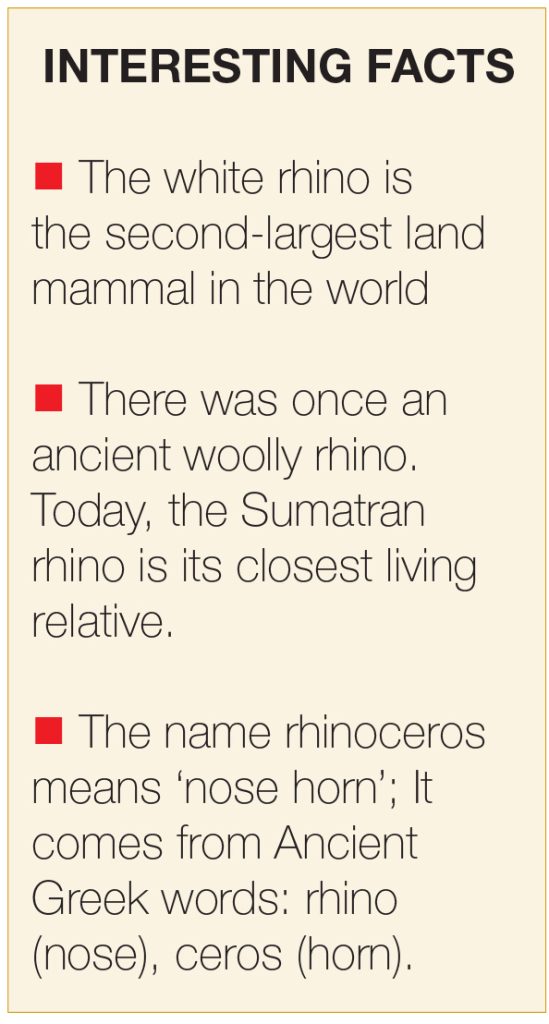There is no need for lengthy introductions – this is a serious call to action!
Illicit wildlife trade is the world’s fourth largest illegal industry, worth between $7billion and $23 billion each year, according to the United Nations Office on Drugs and Crime, which alone indicates that the sustenance of this industry is based on the continuous exploitation of natural resources by criminal syndicates.
With less than 30 000 rhinos left in the world, could the world’s enduring adoration for the famous animal be coming to an end?
In Namibia, despite famed conservation efforts, close to 300 rhinos have been poached over the past 4 years (2020 to 2023), according to wildlife reports from the Ministry of Environment, Forestry and Tourism.

The global rhino population has dropped by 96% over the last century, and statistics from numerous conservation groups indicate that if current trends continue, future generations may never see a rhinoceros in the wild.
The International Union for Conservation of Nature (IUCN) classifies black rhinos as critically endangered, a status reserved for creatures that are extremely vulnerable to extinction in the wild. Southern white rhinos are classified as near threatened, while northern white rhinos are classified as critically endangered.
Namibia has the second-largest rhino population in Africa, after South Africa, and the world’s largest black rhino population.
According to the Rhino Recovery Fund and International Rhino Foundation, the country’s black rhino population stands at over 2 000 individuals, showing a steady increase as a result of dedicated conservation and management programmes implemented by the Namibian government and like-minded stakeholders, custodians, and communities.
Despite Namibia’s concerted conservation efforts, rhinos in the country remain under threat. In 2020, 40 rhinos were poached.
An increase of 7.5% was recorded the following year with 43 being killed. By 2022, the highest record of 87 individual rhinos poached was reported by the environment ministry.
Illegal poaching and habitat destruction have all had a devastating impact on black rhino populations.
This critical condition is determined by various factors, including habitat suitability, population size, rate of decline and geographic distribution of rhinos. To put it simply, the fewer rhinos there are, the closer they are to extinction.
HOW BAD IS IT?
The northern white rhino (a subspecies of the white rhino) is declared extinct in the wild with only two left on the planet! Fatu and Najin (both female) are the only remaining individuals from the subspecies, kept in Kenya’s Ol Pejeta Conservancy.
There are five rhino species: white rhino, black rhino, Sumatran rhino (critically endangered, with an estimated population of 34 to 47), greater one-horned rhino (vulnerable, with an increasing estimated population of 4 000) and the Javan rhino (critically endangered, with an estimated population of 76 and 12 recorded missing).
The first two are found in at least 15 African countries like Namibia, Botswana, South Africa and Kenya, while the last three are found in Nepal, India and Indonesia.
Namibia has two of the five rhino species: black rhinos and southern white rhinos.
To clarify, these rhinos are not actually black or white in colour. The distinctions between them lay in the shape of their mouths, beneath the surface, in the specifics of their physical characteristics, behaviours, and habitat type.
Black rhinos: The black rhino, distinguished by its hooked lip, is a browser that feeds on bushes and trees. It is more solitary and territorial than the white rhinoceros. Additionally, they are smaller and much shorter in height compared to their counterparts.
Southern white rhino: The larger and more social southern white rhino has a wide, square mouth that is ideal for feeding on grasslands. Although classed as near threatened, the southern white rhino is also endangered, with poaching posing a constant threat to its survival.

CONSERVATION EFFORTS
Namibia is a signatory to numerous global conservation treaties and agreements including the Convention on International Trade in Endangered Species of Wild Fauna and Flora (Cites), which governs wildlife trade and has over 180 signatories.
It established a global ban on international ivory and rhino horn trafficking in 1990, which has created a framework suitable for the conservation and sustainable maintenance of flora and fauna.
Cites continues to monitor and enforce regulations through annual reports, updates and stakeholder engagement.
Additionally, the country works with organisations like IUCN with a rhinoceros specialist group which develops and promotes rhino conservation strategies, as well as the Southern African Development Community Protocol on Wildlife Conservation and Law Enforcement which promotes coordinated wildlife protection and law enforcement efforts in southern Africa.
Despite the ongoing battle against poaching, Namibia has emerged as a rhino conservation powerhouse. Government actions, backed by international organisations and local communities, have considerably increased protection efforts.
The environment ministry has made significant investments in anti-poaching operations by providing rangers with training and surveillance technology such as drones and tracking devices. Their purpose is to track rhino movements and intervene in poaching operations before they become widespread.
“We remain committed, on a national level, to counter the strategies of poaching syndicates, hence our collaboration with continental and global conservation groups. We recognise the socio-economic implications of their vulnerability and as the primary custodians of the species in the country, we are working to use innovative, technology-based solutions to tackle this crisis” says Ministry of Environment, Forestry and Tourism spokesperson Romeo Muyunda.
Private organisations, such as the Save the Rhino Trust Namibia and the Black Rhino Custodianship programme, alongside the ministry, have played important roles in the conservation of especially desert-adapted black rhinos and their populations at large.
These groups collaborate with local Namibian communities, appointing them as ‘custodians’ of rhinos in their territories. This collaborative strategy not only strengthens communities, but also makes them active participants in the battle against poaching.
Namibia’s Black Rhino Custodianship programme is considered by many as one of the country’s most notable conservation success stories, where over a third of the country’s black rhino population resides on freehold and conservancy land (outside of national protected areas). This is a testament to the strong private and conservancy conservation efforts and the value that black rhinos bring to the private and communal tourism industry.

BILLION-DOLLAR INDUSTRY
Undeniably, strides have been made to maintain and grow the numbers of these species in various parts of the world, but they remain at risk primarily because of the illegal trade market. Greatly desired for their horns in underground markets, it is reported that the horns are worth more than gold.
Rhino poaching is carried out by highly organised, well-funded and frequently dangerous criminal groups that exploit security flaws and vulnerabilities of the states in which the animals are found.
Asian countries, mainly China and Vietnam, are the primary consumers of rhino horns, which are traditionally speculated to have medicinal benefits, and they are often used as status symbols, although the World Wildlife Fund has debunked many of these claims, emphasising that there is no scientific evidence to support the horns’ medicinal benefits.
THE DOMINO EFFECT
The extinction of rhinos and other vital species would set off a disastrous chain reaction throughout Namibia, harming not only ecosystem but also the livelihoods of thousands of people.
Namibia’s tourism industry, which is primarily based on wildlife, provides considerable revenue and employment (7.9 % of total employment) to the country. The Namibia Tourism Board provides annual statistics on the economic impact of wildlife tourism.
The extinction of rhinos would be a significant blow to eco-tourism, which relies on the appeal of Africa’s ‘Big Five’ – rhinos, elephants, lions, leopards and buffalos.
Tourists visit national parks like Etosha to see these creatures in their natural habitats, and a loss of species would significantly reduce the park’s popularity.
As animal populations decline, so will visitor numbers, hurting local tourism companies and operators, hotels, lodges and conservation efforts. These jobs, many of which are located in rural areas, are critical for communities where employment opportunities are already few.
RECOMMENDATIONS
The general populace may help rescue Namibian rhinos by supporting anti-poaching campaigns, raising public consciousness and contributing to conservation activities.
People can support or volunteer with organisations such as Save the Rhino Trust Namibia, which works directly to conserve rhino populations through tracking and anti-poaching patrols. Participating in eco-tourism, visiting reserves and campaigning for stricter wildlife protection, laws are effective ways to assist.
Furthermore, raising awareness about the repercussions of poaching reduces demand for rhino horn goods, which helps to reduce illegal commerce.
Every tiny effort, whether financial support, advocacy, or volunteer work, can have a significant impact.
Stay informed with The Namibian – your source for credible journalism. Get in-depth reporting and opinions for
only N$85 a month. Invest in journalism, invest in democracy –
Subscribe Now!


